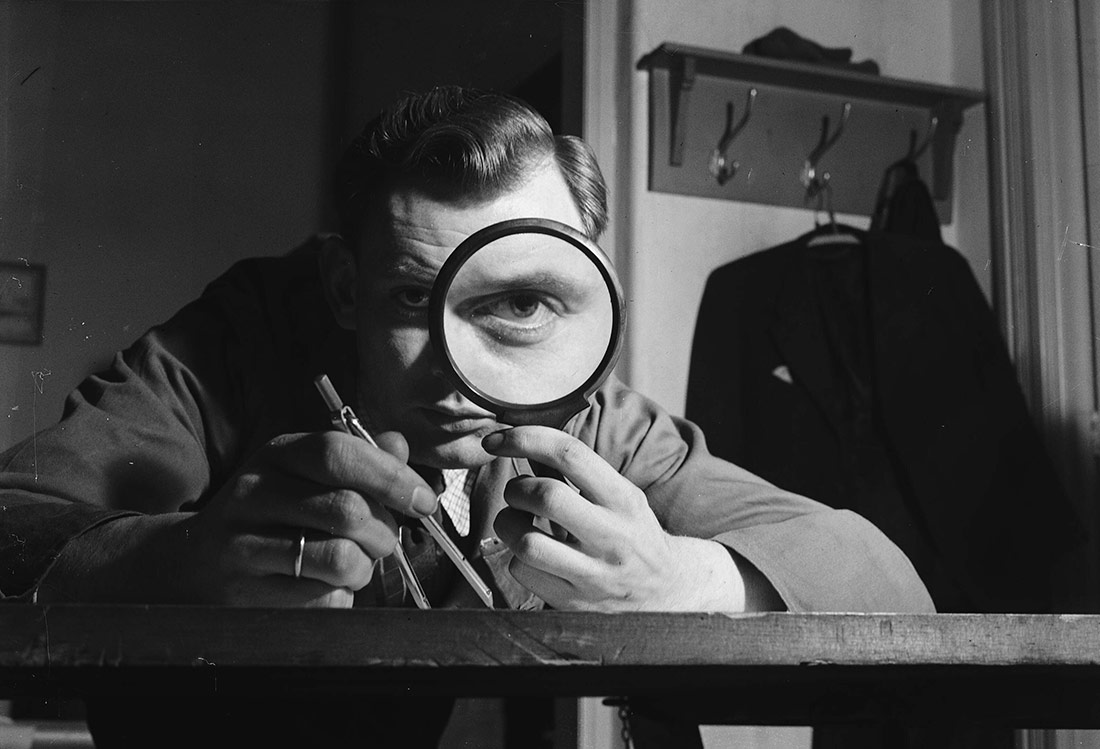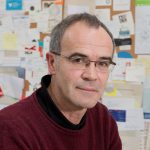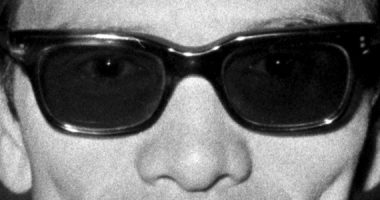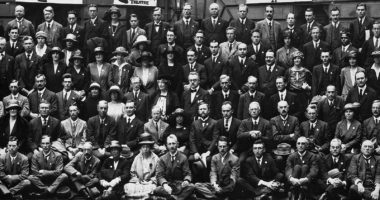
Man with a magnifying glass. The Hague, 1946 | Koos Raucamp, Nationaal Archief | Public domain
The semantic inflation of the suffix lab forces us to reflect on the unfinished history of laboratories and their future as one of the spaces for knowledge that span the whole planet. Second instalment in the trilogy inspired by the quote from Michel Serres: “Planet: laboratory, habitat and altar!”.
It is surprising that a comprehensive history of the laboratory has not yet been produced.
Henning Schmidgen
A much more arduous desire is at stake: that of illuminating a poem in which science sings.
Maria Negroni
Since the beginning of the 21st century, dizzying changes have taken place in the main spaces of knowledge. Classrooms have been subject to continuous mutations due to the influence of the latest educational trends, favouring a more participatory and collaborative approach, but they have also been affected by the disruptive force of new technologies. Libraries have gone from being places reserved exclusively for reading and consulting books to become multimedia centres where users can access the main digital media and attend courses, workshops and conferences that were unthinkable in the last century. Finally, laboratories have not only evolved towards a more empirical and practical approach, but they have also been subject to semantic inflation, with the suffix lab becoming so fashionable that it is now affixed to everything from citizen laboratories to unicorn incubators, from political and corporate clusters to sophisticated facilities where all the possibilities and promises of the hard sciences – driven by exponentially fast AI – are researched, developed and applied.
However, along with these accelerated changes have come a number of national and international reports which have generated recurring waves of concern on evaluating progress or regression in education, reading and writing skills, the ability to understand information, attention and concentration time, as well as the development of abstract, creative and critical thinking. This concern has even manifested itself as “epistemological unease,” suggesting the need to continue pursuing an in-depth revision of the intellectual, social, economic and political fabrics in which we are immersed. Although the main scientific epistemologies have been empiricism, rationalism and constructivism, each in conflict with the others, perhaps the time has come to try to reconcile them through a holistic epistemology [1] that allows for a broader, more heterodox and integrative vision of the ways in which we understand and construct worlds, while also revisiting those forms of knowledge that we consider irrational, wild, primitive or outdated.
Laboratorium [2]
In a 16th-century wood engraving, two alchemists work busily amidst a fantastic mess. The one on the left holds a vessel in an athanor in which fierce little clouds can be seen wafting out of the fire. The alchemist has his eyes closed and his mouth half-open. In the centre of the scene, the second alchemist is scratching his head with his right hand. We could think of it as a medieval comic strip. The engraving reveals flasks, bellows, mortars, stills, balances, long pipettes, etc., but the scene as a whole conveys a hilarious bewilderment. However, if we observe other engravings from the same century, we discover large spaces dedicated to alchemical work in which the instruments are arranged in orderly fashion, as if waiting to be used in a precise and controlled manner. The cliché is that alchemists sought the transmutation of metals into gold – the philosopher’s stone that would allow, among other things, the immortality of the officiant. The usual conclusion is facile – that it is outdated knowledge typical of the obscurantism of the Middle Ages.
It is often forgotten that alchemy is a discipline that brings together several philosophical traditions spanning nearly four millennia and three continents. Its contributions to the craft industries of its time, such as the production of gunpowder, the analysis and refinement of minerals, metallurgy, the production of dyes and cosmetics, the tanning of leather, the manufacture of pottery and glass, and the preparation of extracts and liquors, are underestimated. Moreover, evidence that some of the pioneers of modern science such as Tycho Brahe, Isaac Newton, Johannes Kepler and Robert Boyle were also alchemists is ignored. [3]
Natural philosophers
William Whewell, Charles Babbage, John Herschel and Richard Jones, the Magnificent Four from Cambridge, did not practice alchemy, but they maintained the utopian hope of understanding the world as a whole. Throughout their lives they were firm friends, [4] sharing discoveries and disappointments, wonder and disagreements about the transition that would lead to the birth of modern science as we know it today. They all read Greek, Latin, French and German, and their interests spanned the natural and social sciences and most of the arts. Inspired by Francis Bacon, they dreamed of a science with its own method, open to all the other emerging disciplines. They knew that scientific progress is a social process. Advances are not made in a vacuum, but in the midst of the political, economic and military turmoil of each era. If they had been born in the second half of the 20th century, they would have been men of the third culture, interested even in the criticisms of science born in modern laboratories, precursors of authors such as Bruno Latour, Michel Serres or Paul Feyerabend. They were the last exponents of an almost extinct species – the natural philosophers. They would also be displaced by the progressive emergence of the two cultures that drastically separate art and science, philosophy and science, and science and the humanities.
Revolutionary instruments
Microscopes created and perfected by optical artists to study the microcosm of infections and ferments. Increasingly precise telescopes to scrutinise the irreversible depth of the Copernican turn. Thermometers to gauge the temperature of bodies and the expansion of materials with rigorous measurements. Analytical balances to precisely measure the mass of chemicals. Light itself broken down into wavelengths to explore the electromagnetic spectrum. Centrifugal dances of particles to obtain the separation of mixtures… How could we fail to be amazed by the powerful instruments of modern laboratories, which have been constantly improving and multiplying since the 19th century?
The theory of relativity, quantum mechanics, the irruption of cybernetics and the deciphering of the genetic code were overly powerful revolutions that radically transformed the laboratories of the modern era, extending their networks, placing their tools in every corner of the planet and in the immensity of outer space. The laboratory has never ceased to be planetary or interplanetary.
On the flipside of this portentous deployment is the fact that thousands of disenchanted scientists have been subjected to the demands of the creed of extractivism and productivism, whose most revered gods are war, capital and, ultimately, the fetishes of permanent innovation and programmed obsolescence. The expansion of the modern laboratory can only be understood in the context of clearly defined tasks and objectives to favour and accelerate needs, applications and artefacts according to the different industrial revolutions that have taken place since the 18th century.
Martians, trees and isotopes
The more we lose our awareness of relationships and connections, the more impoverished our view of the world becomes. We can either stay and live in what has become the big theme park of the mind, or continue to expand our cognitive freedom to admit all the actors and agents involved in the assemblage of what we call “reality.” Hard reductionists get angry when dragons and lycanthropes are allowed to run free on the same level as protons and electrons, but nothing prevents us from connecting them in some way, as that is why we have invented “fiction.” And, what is more, science and fiction work in mysterious ways. The whole story is always a work in progress, as demonstrated by the amazing stories of science itself.
Percival Lowell, an eccentric and obstinate American astronomer, founded the Flagstaff Observatory in Arizona (1894), convinced that Mars had canals built by a civilisation affected by water shortages, droughts and accelerated climate change. However, on Lowell’s own turf, a young astronomer named Andrew E. Douglass proved that the canals did not exist and turned his attention to the study of sunspots and how to extend the observations begun by Galileo in the 17th century. Douglass suspected that periods of maximum solar activity had to leave some kind of trace in the Earth’s climate; he faced many obstacles and much resistance to his research, but like Lowell, he was stubborn, bold and resolute, so much so that today he is known as the father of dendrochronology — the method used to determine the age of trees by studying the rings that form on their trunks. In the 1960s, this led to the C14 method, which allows us to use this carbon isotope to date the age of anything organic [5] — animal bones, human skeletons, holy shrouds, pieces of wood, symbols on a papyrus… And to all the revelations, theories and speculations that this radioactive fingerprint brings with it. Like the intuition that nature prefers scarcity to abundance or that longevity is related to triumph over a series of adversities. What began as an obsession with Mars ended up allowing us to date the first human civilisations. A monumental blunder can eventually become the most profound knowledge of the time. Science is a fiction that always legitimises its story. Fiction is also a science that operates through innumerable trials and errors.
The book of nature has been written without borders between disciplines or sterile dualisms. This was known by Rachel Carson, who anticipated the silent springs in the sixties, by Dave Goulson, who imagines the consequences of a world without insects, Robin Wall Kemmerer, who explores the fascinating secrets of moss, Richard Powers, when he narrates the overstory of the forests, and Stefano Mancuso, who turns plant neurobiology into an alchemical, literary and scientific art.
Planet Earth is the classroom where we never stop learning, the infinite library hidden in the ice, the vast laboratory where all living beings interact in a timeless dance that, as in Ovid’s Metamorphoses, [6] becomes a celestial and telluric breviary of ontology and gnoseology for understanding how we learnt to think. A song where bacteria, fungi, insects, fish, molluscs, mammals, palm trees, birds, cereals, reptiles and orchids are all linked together. An endless melody that perpetuates the power of wonder, guided by humility and perseverance in search of a possible utopian or longed-for full attention over everything we know and everything we do not.
[1] The unity of knowledge is an ongoing quest. Notwithstanding the difficulties that exist today due to the large number of scientific and humanistic disciplines, the centuries-long task of “integration” continues. Edward O. Wilson explains it masterfully in Consilience. The Unity of Knowledge (Vintage Books, 1999).
[2] See Henning Schmidgen’s critical analysis in his paper on the history of laboratories.
[3] Although the reading of Andityas Matos’s Contrapolíticas de la Alquimia (NED Ediciones, 2024) came after my reflections on alchemy, I suggest reading Matos’s book. It is a stimulating and thought-provoking work.
[4] For an in-depth account of this fruitful friendship, see Laura J. Snyder’s excellent book The Philosophical Breakfast Club: Four Remarkable Friends Who Transformed Science and Changed the World (Crown, 2012).
[5] Willard Frank Libby was the inventor of the carbon-14 dating technique. He won the Nobel Prize in Chemistry in 1960 for the development of this method for time analysis. His system has revolutionised fields such as archaeology and anthropology, making it possible to determine the age of organic materials up to 40,000 years old. The Laboratory of Tree-Ring Research founded by Douglass put Douglass’ knowledge at Libby’s service, since thanks to dendrochronology, plants formed a time series of more than nine thousand years that served as a benchmark for calibrating the radiocarbon technique.
[6] It is curious to see how Michel Serres and Stefano Mancuso, two “third culture” authors, both resort to Ovid’s classic to exemplify the fascinating transformation of terrestrial ecosystems, revealing a process that is almost impossible to systematise and which has influenced the ways in which we think and invent, just as the Roman author intuited in the first lines of his work, invoking the language of forms transformed into new bodies, uninterrupted from the origin of the world to our own time.





Leave a comment